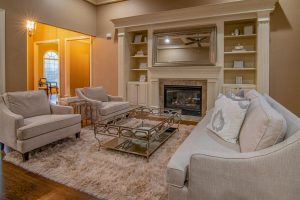If you live in a split-level home, you may be wondering how to decorate it to maximize its unique features and make it feel like home. A split-level home typically has three or more levels, with the living room, kitchen, and dining room on the main level, bedrooms on the upper level, and a family room and additional living space on the lower level. In this article, we will discuss the best tips and tricks for decorating a split-level home to create a cohesive and comfortable living space.
1. Define the Main Living Area
The main living area of a split-level home is typically on the main level, so it’s important to define this space and create a focal point. You can do this by using a large area rug, hanging a piece of artwork, or creating a gallery wall. This will help to draw the eye and make the space feel cohesive.
2. Choose Cohesive Colors
When decorating a split-level home, it’s important to choose cohesive colors that flow throughout the space. You can use different shades of the same color or complementary colors to create a cohesive look. It’s also important to consider the color of the flooring and walls, as these can greatly impact the overall feel of the space.
3. Utilize Natural Light
Split-level homes often have large windows that provide ample natural light. To take advantage of this, consider placing furniture near windows to create a cozy reading nook or simply to enjoy the view. You can also use sheer curtains or blinds to control the amount of light coming into the room.
4. Create Zones
With multiple levels, it can be easy for a split-level home to feel disjointed. To combat this, create zones within each space. For example, in the main living area, you can create a seating area, a dining area, and a workspace area. This will help to define each space and make the overall layout more cohesive.
5. Use Lighting to Define Spaces
In addition to creating zones, you can also use lighting to define each space. For example, you can use pendant lights over the dining table or a floor lamp in the seating area. This will help to create a cozy and inviting atmosphere while also defining each space.
6. Add Textures
Textures can help to add visual interest and depth to a split-level home. Consider using different textures in your decor, such as a plush rug, velvet pillows, or a woven basket. This will help to create a layered look and make the space feel cozy and inviting.
7. Consider the Flow
When decorating a split-level home, it’s important to consider the flow of the space. Make sure that there is a clear path between each level and that furniture is arranged in a way that makes sense. This will help to make the space feel more functional and inviting.
8. Use Mirrors
Mirrors are a great way to create the illusion of space in a split-level home. Consider hanging a large mirror in the main living area or in the hallway to make the space feel larger and more open.
9. Add Plants
Plants are a great way to add life and color to a split-level home. Consider adding potted plants or hanging plants throughout the space. Not only will they add visual interest, but they can also help to purify the air and improve indoor air quality.
10. Incorporate Storage
With multiple levels, it’s important to have ample storage in a split-level home. Consider incorporating built-in shelving or bookcases to provide storage and display space. You can also use storage ottomans or baskets to keep clutter at bay.
11. Don’t Forget About the Lower Level
The lower level of a split-level home is often overlooked, but it can be a great space for a family room, home office, or even a guest bedroom. When decorating the lower level, consider using warm, cozy colors and textures to make the space feel inviting.
12. Choose Furniture Wisely
When choosing furniture for a split-level home, it’s important to consider the scale of the space. Avoid oversized furniture that can make the space feel cramped, and instead opt for pieces that are proportional to the room. You can also use multi-functional furniture, such as a storage ottoman or a sofa bed, to make the most of your space.
13. Create Visual Interest with Artwork
Artwork is a great way to add visual interest and personality to a split-level home. Consider creating a gallery wall on the main level or using a large piece of artwork as a focal point. You can also use artwork to tie different levels of the home together by using similar colors or themes.
14. Use Area Rugs
Area rugs are a great way to define each space in a split-level home and add warmth and texture. Consider using a large area rug in the main living area and smaller rugs in other areas of the home, such as the dining area or bedroom.
15. Incorporate Personal Touches
Finally, don’t forget to incorporate personal touches into your split-level home. Whether it’s family photos, artwork, or sentimental objects, these items can help to make your home feel truly yours. Consider displaying these items throughout the home to create a warm and inviting atmosphere.
In conclusion, decorating a split-level home can be a challenge, but with these tips and tricks, you can create a cohesive and comfortable living space that truly feels like home. Remember to define the main living area, choose cohesive colors, utilize natural light, create zones, use lighting to define spaces, add textures, consider the flow, use mirrors, incorporate plants and storage, don’t forget about the lower level, choose furniture wisely, create visual interest with artwork, use area rugs, and incorporate personal touches. With these ideas in mind, you can create a split-level home that is both functional and stylish.
FAQs
What is a split-level home?
A split-level home typically has three or more levels, with the living room, kitchen, and dining room on the main level, bedrooms on the upper level, and a family room and additional living space on the lower level.
How can I define the main living area in a split-level home?
You can define the main living area by using a large area rug, hanging a piece of artwork, or creating a gallery wall.



